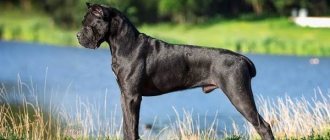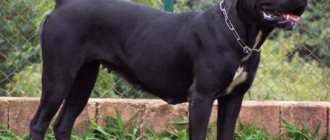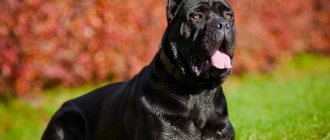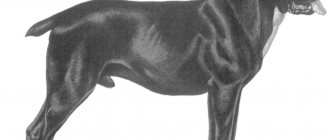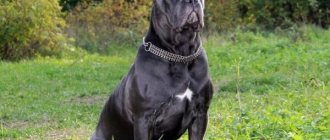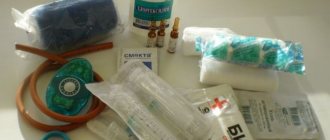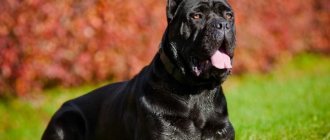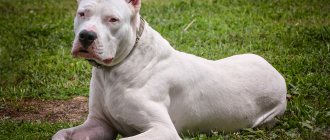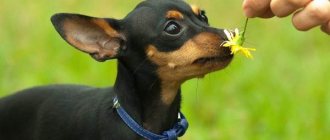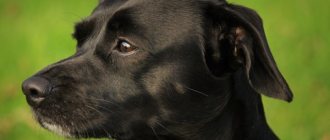Description of the Cane Corso breed
Popularity 23rd among 263 dog breeds
Lifespan:
9-11 years
Breed group:
Sentinels
Height:
males: 64-68 cm, females: 60-64 cm
Country of origin:
Italy
Average price:
20-30 thousand rubles
Weight:
males: 45-50 kg, females: 40-45 kg
Latest articles Cat health
Rabies vaccination for cats: choice of vaccine, necessity, schedule 01/22/2022 4 0 0
Selection and adaptation
TOP 20 best cat breeds for families with children 01/22/2022 25 0 0
Vaccinations
Mother's milk, which puppies are fed in the first weeks after birth, provides their immunity. When the lactation period ends, the babies' protection from infections and diseases disappears. It is replaced by immunity independently developed by the puppies.
| Age | Graft |
| 6-8 weeks | Vaccine against enteritis and hepatitis |
| 8-10 weeks | Revaccination + vaccinations against parvovirus, adenovirus and parainfluenza |
| 2.5-3 months | Vaccination against plague |
| 6-8 months | Rabies vaccine (if a plague vaccination was previously given, rabies vaccination is carried out only at 8 months) |
| 7-8 months | Repeated vaccination against plague |
| 1 year | Vaccination against leptospirosis |
| In the future, vaccinations are repeated annually at the same time. | |
Popular drugs for vaccination are Eurican, Duramune, Nobivac.
Vaccination is not a method of treating a disease, but its causative agent, so it is important that the puppy is absolutely healthy at the time of vaccination.
Advantages and disadvantages
- Pros:
- calm, friendly;
- quick-witted;
- gets along at home without special preparation or preliminary training;
- finds a common language with others;
- possessor of ideal security qualities;
- It is not fussy to care for and does not require daily hassle.
- Minuses:
- excessive salivation;
- long molting time;
- intolerance to low temperatures, it is better not to keep the cane outdoors or in a cage;
- Dog food costs are high;
- requires constant walks, games, physical activities;
- Due to energy, joint disease may develop.
Dog body parameters
The documents clearly define the parameters for each part of the dog’s body and even its character. So that you have a general idea, we will first give them briefly, and then consider each point in more detail and talk about the possible shortcomings and vices of the Corso.
The ideal representative of the breed must fit all the given parameters and have:
- correct proportions of the body and head; - good teeth and bite; - flexible, friendly character; - healthy gait with wide strides; - suitable height and weight; — the desired color is one of those included in the standard.
For mating, knowledgeable dog breeders take only those representatives who meet all the requirements of the standard.
Let's consider all the points in detail, because everywhere there are nuances and reservations, and the approach to dogs at various competitions can be contradictory.
Key facts
The description of the Cane Corso breed says that the dog is an excellent guard, he is endowed with the instinct to protect his own territory. The dog will protect its owner and will not give him offense. The hot Italian blood of the dog will play into your hands at the right moment if a burglar breaks into the house.
This breed is endowed with strength and strong muscles. Corsos are smart, hardy, and energetic. To maintain shape, they need regular strength training. Despite their outward calmness and even carelessness, Cane Corsos are active. Dogs love to play outdoors and participate in marathons. The fiery Italian breed has its origins in herding dogs. Hence, animals retained their kindness and desire to control everyone. Therefore, the pet will be able to look after the children.
Cane Corso owners are very lucky: they are the owners of an ancient breed of gladiator dogs. A noble glow of severity and seriousness seems to emanate from them. Cane Corso have changed over the centuries-old history of their breed, softened their disposition and now easily find a common language even with children.
This breed was bred in hot Italy. The country is proud of dogs for a reason, because the characteristics of the Cane Corso breed almost scream that the animal is a real work of art, and not a dog. Thanks to its sensitive intuition, this breed will serve as a security guard better than any alarm or watchman.
The Cane Corso's lifespan is not very long, but this is considered normal for large breed dogs. In good conditions, an Italian dog will live up to 12-13 years.
History of the breed
In translation, “cane” means “dog”, but “corso” has several translation options - “yard”, “guard”, “fighter”.
But in any case, the name of the breed can be literally translated as “a dog that guards the yard and can be used in military operations and battles.”
The versatile Cane Corso dog is often mentioned in various Italian works; it was depicted on ancient tombs, poems were dedicated to it, and sayings and songs were written about it.
The fall of the great Roman Empire also affected dog breeding.
In addition, the new aristocracy did not want to keep this dog in their yards, since it had acquired popular fame. All this became the reason that the breed began to mix with other species and lose its true appearance.
In 1976, Breber revived interest in this breed, and in 1994 the Cane Corso was officially recognized.
Then the breed began to gain popularity, and today these wonderful dogs again live with people and give them their devotion and protection..
History of the origin of the Cane Corso
The interesting history of the breed goes back to ancient times. Harsh times required protection of people, support, and a sense of security. The ancestors of the Cane Corso served as guards against wild animals and surrounding enemies.
The closest ancestor to the type of Cane Corso breed that exists today is the Tibetan Great Dane, bred three thousand years ago. The territory of their origin is now called Eurasia. Perhaps the Cane Corso inherited the burning Italian anger from the Tibetan Great Danes.
Over time, the breed expanded beyond its range and was modified by crossing with other breeds. Most often they were used for defense and attack, and participation in military campaigns, but in China, Tibetan Great Danes participated in dog battles.
Cane Corso has been documented in documents since the 14th-15th centuries. Their service in hunting and fights was described; other individuals were used as shepherds. All this is recorded in the chronicles, but there is an established history of the appearance of Corso dogs as a breed much earlier - the roots go back to the heyday of the Roman Empire. Statues, frescoes, and columns depicting this breed were found in Roman cities. On them, noble, stately dogs faithfully followed their owner, accompanying him on the hunt or sitting majestically at the throne of the emperor.
Nothing lasts forever and the Roman Empire collapsed. The Corso breed has undergone changes - namely, crossing with Celtic greyhounds. The innovation changed the dogs for the better, their character softened, and now Corsos - fighting dogs, the threat of enemies - become guards of animal herds, faithful assistants to farmers.
For many centuries, they tried to preserve the Corso, leaving the optimal genotype unchanged. It turned out that after the outbreak of World War II, the dogs were redirected to service. They carried heavy loads, helped soldiers and civilians, because of which many representatives of the breed died, and malnutrition crippled the ideal genetic chain of dogs. The world did not want to say goodbye to the hardworking animal, and the gap in the development of the breed was patched by Giovanni Banatti Nizzoli.
Having exerted a huge amount of effort, spending time and their own resources, Italian breeders collected purebred Cane Corso dogs and managed to bring them to the ideal level. A standard for purebred dogs appeared.
The description of the external features that distinguish the Cane Corso from other dogs, including non-purebred ones, has been officially established. After the approval of the breed at the global level was completed in 1994, the number of dogs of this breed soared several times.
Brief historical background
The Italian Cane Corso is one of the youngest officially recognized and rapidly gaining popularity dog breeds in the world. But, strictly speaking, the history of the origin of these dogs goes back thousands of years. Their ancestors, as well as the entire Molossian group, are considered to be the ancient Roman fighting dogs, which were used in bloody battles in the arena, to protect property and territory, as well as for baiting and when hunting large prey. Huge warlike dogs accompanied armies and took part in battles along with soldiers.
The coat of arms of the ancient aristocratic family “de Corse” features an image of a dog extremely similar to the Italian mastiff. The first mention of this fact can be found in historical documents from 1238.
In a later period, mastiffs found use in everyday life for much more peaceful purposes: they helped shepherds graze cattle, protected houses and their inhabitants, and guarded their property. Gradually, as a result of industrialization, urban growth and technological progress, the need for such multi-skilled, large-sized helpers disappeared, and the Cane Corso population declined greatly. The world wars that soon followed almost wiped these strong dogs off the face of the earth.
In the 70s of the last century, based on several purebred individuals discovered in remote villages, painstaking work began to restore the breed. Already in 1984, a preliminary (so-called temporary) breed standard was developed, and on January 20, 1994, the National Association of Italian Cynologists (SACC) officially recognized the Cane Corso. Recognition by the FCI took place on November 12, 1996, in whose registry the breed was entered under number 343 (group 2 - pinschers and schnauzers, molossians, mountain and Swiss cattle dogs, section 2 - molossians). The standard requirements underwent some adjustments in 2003, the last current current breed standard dates back to December 17, 2015.
The first three Cane Corso puppies (Clara, Julia and Ikar-Misha) arrived in Russia in 1994.
Appearance of Cane Corso
General impression
This large breed looks like a real fighter dog: strong muscles, strong physique. The dogs look in the best traditions of charismatic and temperamental Italy. They are serious, fast, agile, with an ardent character, and the elegance of their movements is similar to that of a cat. All characteristics are visible in the photo of the Cane Corso. The centuries-old evolution and development of the breed ultimately led to the emergence of better results in terms of appearance and character. Through persistent selection, a powerful, strong breed with a kind heart and devotion to its owner was developed. Isn't this the perfect balance?
Head
The structure of the Cane Corso's skull is average with a slope in width, length is not inherent.
The muzzle is square-shaped with strong bones, short, without skin folds, the skin is stretched over the skull. The eyes are widely spaced from each other, slightly elongated and narrow in shape. Eyelids black. Interestingly, the color of the dog’s eyes also depends on the saturation (darkness) of the dog’s fur.
The ears are covered with shiny soft fur without tassels at the corners. They are large in shape; for better perception of sounds, they are spaced far apart on the head. The ears are wide at the base and narrower towards the end and have a triangular shape.
The lips are compressed, the corners are not lowered. The peculiarity of the structure is that the lower lip covers the upper lip. A wet dog's nose is dark black and oval in shape. Medium in size, voluminous nostrils.
The sharp carnassial teeth of the Cane Corso are adapted for any type of meat. They are strong and number 42 in total. Corso teeth always remain white. Hunter-type jaws with a protruding lower jaw create a slight overbite of the teeth.
Neck
Another example of a combination of grace and strength is the corso neck. It is sculpted, powerful, looks organically with the dog’s body, but at the same time flexible, graceful and noble. The size and length are similar to the length of a dog's head.
Torso
In contrast to body length, the dog's height at the withers is somewhat shorter. The croup is voluminous, while the withers rise above it and are therefore quite noticeable. The Cane Corso is an active dog with lung capacity consistent with a wide chest and well-spaced ribs. The dog's back is prominent, the ribs are not clearly visible.
Limbs
The shoulder blades, adapted for active activities, are connected to the dog's front legs.
There is a strong structure of the entire musculoskeletal system, extraordinary feline grace due to the soft pads on the back of the oval-shaped paws. The muscular hind limbs perform an excellent jumping function thanks to elastic muscles and strong bones. The hips are wide, stand out against the general background, extended towards the spine. Like the front legs, the Cane Corso's hind legs are oval, with protective pads and sharp nails. This structure allows the Cane Corso to cover long distances at high speed without losing the feline flexibility and strength of its ancestors, the Tibetan Great Danes.
Tail
In this breed, the length of the tail reaches the bend line of the hind limbs. Located high on the body, tapering towards the end. The powerful structure of the Cane Corso does not allow it to bend or raise its tail.
Wool
The skin fits tightly over the bones, but does not create a painful appearance. Rough fur structure, short hair, shiny, glossy appearance - an indicator of a pure breed. If otherwise, then this is already a deviation from established norms.
Color
The various colors of the Cane Corso do not fit into one range. These can be standard black, golden-red, striped, ash, dark gray, wet asphalt, red, brick colors. It is not scary if the fur is covered with white spots on the chest or some parts of the body.
Size
The length of the body exceeds the height of the dog (at the withers). On average, the height of Cane Corso in females is 60-65 cm, in males - 61-55 cm. The large structure of fighting dogs corresponds to their weight - from 40 to 50 kg, depending on gender and age. The maximum weight of the Cane Corso reaches 55 kg for particularly powerful representatives of the breed. The size of the Cane Corso suggests that the dog will be given a spacious place in an apartment, or better yet, in a private house.
Distinctive features
The Cane Corso is a medium-sized dog with well-developed, defined muscles. The format is elongated, the length exceeds the height by 11%. Outwardly he looks strong, graceful, confident. The coat is short, shiny, and lies close to the body.
The last standard was published in 1999. According to it, all dogs that do not meet the standards of behavior and external characteristics are discarded.
- The head is wide, square, small and shallow. Convex cheekbones . The brow ridges and frontal sulcus are visible Characterized by fleshy folds of skin on the forehead and near the lips.
- The muzzle is not long (4/10 of the length of the skull), but wide and voluminous. The bridge of the nose is straight. The jaws are strong, powerful, the upper one is slightly shorter, “undershot” type bite The lips are drooping, the upper one overlaps the lower one and forms an arch. Pigmentation is black.
- The nose is straight, large with open wide nostrils, black.
- The eyes are medium in size, set quite wide and deep (under the overhanging eyebrows). The eyelids are fused at the corners and have bright black pigmentation. The color of the iris is dark, almost black.
- The ears are large, set high, with a wide base. It is customary to cut to an equilateral triangle; otherwise, they hang down on the sides of the head and reach the cheekbones. Covered with short thick hair.
- The body is strong, elongated, with developed muscles. The back is straight and wide, slightly raised towards the neck. The loin is short and strong, slightly arched. The croup is slightly sloping. The chest is wide (35% of the height at the withers), deep (reaches the elbow joint), and protrudes forward. The ribs are rounded. The neck is muscular, equal in length to the head, arched, oval in cross-section. There is no suspension. The belly and hemline are well defined.
- The tail is long (below the hocks), thick at the base, tapered towards the end. Set below the lumbar line, lowered when calm. When active, it does not rise above the croup, but may bend slightly. It is customary to dock at 2/3 of the length.
- The limbs are straight and parallel, perpendicular to the ground, and have a straight posture. The muscles and bones are well developed. Paws are oval (the hind legs are slightly elongated); with fingers clenched into a ball. The pigment of the claws is black. The movements are like a trot, a little stretched out.
- The skin is thick, but fits tightly to the body, forming folds on the head and muzzle.
- The coat is short, flat, thick, lying close to the skin. There is undercoat, but not long (up to 2 cm).
- Colors: black, gray, tan, red, brindle. In red and brindle cats, a black mask is acceptable, and small white spots on the chest, paws or bridge of the nose are also allowed.
Character of the Cane Corso
Due to their strict appearance, many people consider Cane Corsos to be aggressive strangers from distant Italy, with a reserved disposition and severity, but this is not so. In fact, Cane Corsos are kind and devoted dogs, with a sensitive heart and a vulnerable soul.
If you study the family tree of the breed, it turns out that the Cane Corso is an ideal balance of all the qualities of its ancestors. They are not overly large, not limply soft and not so aggressive.
The breed requires regular exercise to maintain a toned body. It is advisable to train the dog, especially since he will like it. Corsos are smart, resourceful and don't mind learning a trick or two.
Dogs of this breed unnecessarily frighten people. Their menacing appearance to others is a sign of an aggressive character. You should know: the Cane Corso does not attack without reason, but closely watches those around him, wanting to protect his owner from possible danger. Cane Corsos are cute, just give them free rein to frolic - especially puppies under one year old. With age, ardent Italians cool down on games and are more relaxed about entertainment, but do not mind sometimes running after the ball.
The severity and strong character of the Cane Corso will be used in protection. At the right moment, they will turn from a good-natured pet into a fierce bodyguard. This is facilitated by a quick reaction and high speed of movement, as well as a muscular physique and a grip of steel. The aggressor will not escape from the strong teeth of the Cane Corso. Therefore, when training a dog to guard the territory, do not forget to teach it the appropriate commands so that it does not inadvertently injure anyone.
Italian Corsos are devoted to their owner to the last. It is difficult to deceive them and distract them from guarding; they stubbornly stand their ground and do not take their eyes off their owner and family. Dogs do not attack immediately, but warn with a special facial expression, so watch out for this.
The dog cannot stand long periods of loneliness and the absence of its owner. It gets to the point where the sensitive Italian dog, bored, stops eating and moving, and may soon die altogether. Corsos are not just dogs, they are family members, best friends. Dogs cannot live without love and attention. A good owner should understand this and not leave his pet for too long throughout his life.
How to name?
When choosing a nickname for his pet, the owner is free to show maximum imagination. You can remember the Italian roots of the Cane Corso and use something reminiscent of that country.
You can offer other ideas:
- For boys – Archie, Apollo, Albus, Arnie, Baron, Bucks, Wooddy, White, Thunder, Duke, Gore, Dexter, Jack, Dave, Georges, Zidane, Zeus, Crispus, Courage, Krief, Casper, Lyon, Lexus, Mike , Maurice, Nord, Nice, Norman, Oliver, Osman, Onyx, Parker, Prime, Rich, Rider, Ringo, Spartak, Stif, Snike, Sultan, Tyson, Teach, White, Walter, Frank, Hulk, Hallie, Caesar, Chief , Chip, Chase, Shah, Alvin, Ernie, Justin.
- For girls - Alma, Aisa, Angel, Barca, Beta, Bessie, Venus, Vicky, Gloria, Gizma, Dana, Diya, Zita, Zara, Ilsa, Irma, Cassie, Cleo, Keri, Lilu, Lucky, Molly, Maya, Nika , Nancy, Ollie, Piggy, Pixie, Roxy, Richie, Sally, Selina, Stacy, Tori, Terra, Ulli, Ulma, Fanny, Fiona, Flora, Chloe, Holdie, Tsara, Cessie, Chelsea, Sherry, Sheila, Elsa, Ellie , Yumi, Utah.
We must try to name the pet so that the nicknames do not repeat next to each other.
In addition, you should not use nicknames that are similar to the names of family members and teams.
Education and training
What do you know about the fiery temper of the Italian Cane Corso? He does not strive to be a leader, he is devoted to his owner and is ready to carry out all his commands. Hence the easy learning ability and success in raising and training the Cane Corso. Remember that dogs of this breed are big children, they become attached to their owner once and for all.
If you decide to train your puppy without the help of specialists, remember a few rules:
- Teach your little Corso cleanliness and basic commands: “Ugh!”, “Stand!”, “Sit!”, “Lie down!”, “Come to me!”, “Near!”, “Place!”.
- Take into account the baby’s negative qualities and eliminate them as they grow older.
- Do not raise your hand to the puppy, this will make him angry and cruel towards you and others.
- Entertain your baby Corso with walks, games, and physical exercises.
Encourage your pet's success with treats.
Then the productivity of learning will increase significantly. Give your baby compliments, he loves kind words and in return will do his best to please you for your warm attitude. It is important to know: only the owner should raise a Cane Corso puppy, and no one else. Strangers will make the situation worse. Looking for a Cane Corso? Find your pet from 1 offer Buy
Where to buy and price
Not all kennels in Russia offer Corsi puppies. The minimum price is 50,000 rubles, but puppies with documents and eminent parents cost an order of magnitude more. Finding a nursery is possible. It is better to wait for a puppy, being sure of its breed, than to buy it on hand in an unknown place. There is a regular selection of Cane Corso babies in the nurseries ARNAS FIORISTA, Ollada Harlequin, and Dynasty Champions.
Cane Corso has an interesting history; they are one of the oldest breeds of large Molossians, common in ancient Rome. Phlegmatic pets will become real defenders of the owner, his entire family, for children - friends, nannies. The advantages of the breed far outweigh the disadvantages.
Health and illness of the Cane Corso
Possible diseases
This breed is prone to hereditary diseases; study your pet's passport before purchasing.
Most often, the Italian dog suffers from congenital hip dislocation. The disease cannot be treated; in extreme cases, the dog has to be euthanized. Even professional dog handlers do not always see this disease in a puppy, especially since there are no ways to predict it. There is always the possibility of an x-ray procedure, but it will not provide 100% insurance. Possible diseases of the Cane Corso:
- allergy;
- stomach upset;
- epilepsy;
- hyperthyroidism;
- eyelid diseases
Reproductive health
The first estrus in females occurs quite late (compared to most breeds) - at 8 months and later. It is considered normal even if the first estrus was noted after a year. There is no point in breeding a dog before 2-3 heats - pregnancy may not occur. Estrus occurs two to three times a year and lasts three to four weeks. If you don't need puppies and have problems finding a male to breed with, you can sterilize your dog. If you want to get a litter, find a partner suitable for your dog and enlist the support of a specialist. The Corso's pregnancy lasts two months, and labor lasts from 6 to 12 hours on average. It is better if the birth of puppies takes place under the supervision of a veterinarian.
The price of a puppy, how to choose it when buying?
Before you think about buying a puppy, choose the direction in which it will go in the future. Will the dog participate in exhibitions, sporting events, or simply please the eye and enjoy communication with its owners? Accordingly, they are already starting from this.
You should buy a baby when he is at least 8 weeks old and feeding on his own. Its weight should be 8-9 kg. Vaccinations for puppies must be completed and noted in the passport. Next, external data according to the standard is determined.
You should request in advance to provide the parents’ pedigree and inquire about all their genetic diseases. The higher the title of the mother and father, the higher the price for the puppy.
The cost of a good pet in elite nurseries ranges from $300 to $2000. Dogs with a bad pedigree, with unclean blood or that do not meet the standards are sold several times cheaper than usual.
Features of feeding and diet
Carne Corso is designed for vigorous activity, physical exercise, and racing - so it burns a large number of calories. But if you don’t run around the park with your pet and take him to lie down on the sofa for company, a problem with excess body weight, disruption of the gastrointestinal tract and musculoskeletal system appears.
Physical activity and a natural diet for your dog will help prevent troubles. If there is a need to switch your Corso to dry food, choose premium food, no less. This is quite expensive, but cheap Cane Corso food is not suitable - allergies or serious problems with the digestive tract may occur.
Nutrition
When choosing between natural food and dry food, experienced owners often lean towards the second option, because Cane Corso dogs are prone to food allergies. The disadvantage of this solution is the high price of hypoallergenic feed. Pros - it’s easy to calculate the dosage; sometimes you can pamper your pet with canned food of the same brand.
Initially, you can try natural foods to check for allergies. Then you will have to spend a lot of time to create a complete and balanced diet. It is not compiled for life, but is constantly adjusted depending on the age and condition of the animal, its physical activity and even the season.
Cane Corso in the forest in autumn
New foods can be introduced to the puppy only two weeks after he has settled in the new home, and the frequency of feedings must initially be the same as at the previous place of residence. It is advisable to have equal intervals between feedings.
Cane Corso, as a fairly energetic and strong dog, needs a large amount of animal protein. It is found in meat, fish, eggs. Puppies can be fed boiled veal or rabbit.
If the animal is natural, then the menu must include porridges based on meat and other broths. For taste, you can season them with fresh herbs and vegetables. A variety of fruits and salads dressed with yogurt can serve as treats. Under no circumstances should you feed your Cane Corso pork, lard, bones, river fish, sweets, spices, or poultry skin.
Care and maintenance
Living in an apartment is quite comfortable for a dog, but it requires two-hour walks every day. A change of environment will make your pet happy and will not let him get bored. During a walk, the relationship between the owner and the dog is improved, diseases of the musculoskeletal system are prevented, metabolism is accelerated, and the nervous system is strengthened.
The Cane Corso's coat is short, hard, and the undercoat is not thick. The need for combing is minimal: only during the molting period is it necessary to remove excess hair every day. Molting occurs twice a year: in spring and autumn.
Inconvenience can be caused by excessive salivation - it can increase in the hot season. If you get used to this, the Cane Corso will seem like a very clean dog. Caring for and maintaining a Cane Corso does not create problems for owners.
The dog does not emit an unpleasant odor, and yet it does not need to be bathed often. Thorough washing 1-2 times a month is enough, the rest of the time it is recommended to use dry shampoos. They will preserve the luxurious appearance of the Cane Corso, protect against infections, and prevent the appearance of parasites.
Dogs are at high risk of contracting ear diseases. You should take care of your ears with a cotton pad: they remove dirt. It is advisable to repeat the procedure 2-3 times a week, then the risk of ear infections will be reduced to a minimum. If the situation worsens, contact your veterinarian.
Don't forget to take care of your Cane Corso's strong teeth. Buy specialized toys for cleaning teeth; dry food is also suitable. Do not let your pet chew on hard objects - they can damage the animal's gums.
To prevent infections, the Cane Corso's eyes are wiped with a cotton pad soaked in a natural chamomile decoction. Also monitor the condition of the pads on the paws, prevent the appearance of cracks, they are a source of infection. To heal cracks, use an antiseptic or wipe with vegetable oil. Contact your veterinarian to prescribe the necessary medications for your Cane Corso based on your dog's weight, age, and health.
Popular types
Even if the Cane Corso's appearance is related to other dog breeds, it cannot be considered a mestizo, since this breed is relatively young and may have heterogeneity that will disappear over time.
Currently there are the following types of Cane Corso::
- Great Dane. This is a tall, slender dog with a long muzzle. The head is light, the chest is narrow. A calm dog with a slightly touchy disposition, very attached to its owner and has an excellent memory.
- Mastiff-like. A dog with highly developed muscles, a large head, heavy lips and eyelids. The skin forms folds. An excellent guard, but does not tolerate heat well.
- Bullmastiff type. Loose, muscular dogs with a wide back and developed chest. There are many folds on the muzzle, the eyes are set close. Stubborn and very active dog.
- Boxer type. The shape of the body is square, no muscle strain is observed. A strong dog with a small head and wide-set tails. Cheerful, active, a little eccentric.
- Staffordshire Terrier type. Muscular back and chest, wedge-shaped muzzle. Very active, but somewhat aggressive towards other animals.
As for the color of the dog, it is different.
When choosing a puppy, it is recommended to pay attention not to the color, but to the design of the future pet.
An excellent breeder and star of the ring may be of the most common color, but a dog with a rare color may have significant disadvantages in this regard and live in a family as a pet.
White
White color should not exist in nature; white Cane Corso is a breeding marriage.
Since the gene responsible for white color usually carries mutations, breeders consider it lethal.
Such dogs are culled, and the puppies are given documents that do not allow them to breed..
Redheads
This color is popular among breeders. The shade can be dark or light.
The intensity of the color depends on the individual external characteristics of the puppy's parents.
All varieties of Cane Corso may have spots on the chest and “socks” on the paws..
Such features do not at all make the dog unsuitable for breeding or participating in exhibitions.
Gray
Gray Cane Corsos can vary in tone - from light blue to lead .
There are breeders who breed slate gray or even asphalt colored dogs. These dogs look like bleached black dogs.
Fawn
This is a rare color.
As a rule, puppies are born gray, but the adult dog becomes fawn..
In this case, the mask is preserved, the color remains blue or gray.
Blue
The blue color is close to gray, and most often the dog itself is gray, and the mask on the face can be blue.
Brindle
Black and brindle Cane Corsos are standard colors.
Read about other breed standards here.
Brindle dogs may look almost yellow, but their fur has red stripes..
If the dog’s pedigree included ancestors with black fur, the stripes may also be black. These Cane Corsos are called black brindle.
Tips for choosing a puppy
This breed of dog is luxurious and expensive, so before you decide to buy a Cane Corso, familiarize yourself with the nuances of the breed, its pros and cons, and maintenance features. Immediately before purchasing, check the puppy’s passport for all the necessary criteria for purebredness and the absence of hereditary diseases. Study the puppy’s parents, take a closer look at the puppy’s character, external signs, and habits. Externally, healthy Cane Corso puppies look energetic, with a strong build and curious eyes.
Varieties
The purebred Italian Cane Corso is included in the international standard as a separate breed. However, there are mastiffs (large and powerful dog breeds whose ancestors fought in the arenas of Ancient Rome) that are similar in appearance to the Cane Corso. The main ones include:
- German boxer.
- German dog.
- Bullmastiff.
- English Mastiff.
These breeds are indeed similar to the Cane Corso and have family ties to the breed, but they differ in behavioral habits and many other characteristics.
How much does a Cane Corso cost?
The price of a Cane Corso varies greatly, it starts from 150 and goes up to 1000 dollars. The cost depends on the puppy’s health, purebred and physical development. It is possible to purchase a Cane Corso for a low price with a pure line of pedigree, without impurities, but the health of such an individual can be undermined. In the Russian Federation, dogs are purchased for a small price, but this is a matter of luck. It is dangerous to rely on the quality of the breed without having a puppy passport.
To avoid problems, it is advisable to buy a Cane Corso from experienced breeders or in specialized nurseries with all the required documents.
- A middle class puppy can be purchased for between 600 and 800 dollars. Externally, the baby may differ slightly from the ideally pure version of the breed.
- A higher-end puppy will cost you between $800 and $1,400.
- You can buy a presentation breed puppy for no less than $1,400, sometimes the price reaches $2,000. It is worth it - the puppy will have all the relevant documents, ideal appearance, purebred, without hereditary diseases.
Premium class puppies can confidently participate in exhibitions and take prizes.
Experts advise paying the appropriate price rather than trying to sell it on the cheap. Do you like the article? 0
Nicknames
A brutal, expensive dog needs an appropriate nickname. It would never occur to anyone to call a Cane Corso a Ball or a Bug. Choose a nickname based on your preferences, take into account the character of the animal and its unusual habits.
Short names consisting of two syllables sound best.
| For boys | For girls |
| Bruno | Adele |
| Bruce | Alba |
| Butch | Brenda |
| Viking | Grace |
| Hector | Krista |
| Joy | Lilu |
| Space | Laura |
| Kurt | Sarah |
| Lucas | Chloe |
| Marcus | Chelsea |
